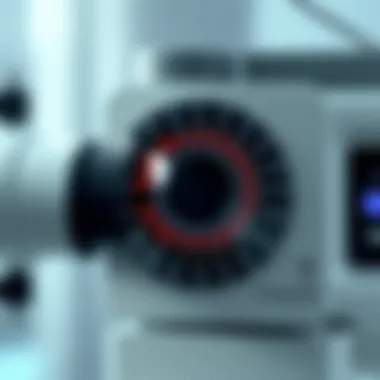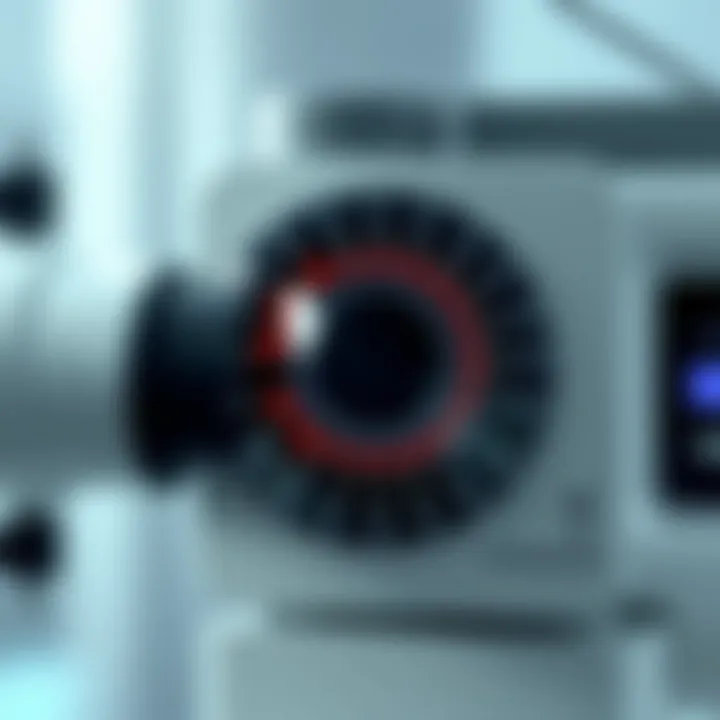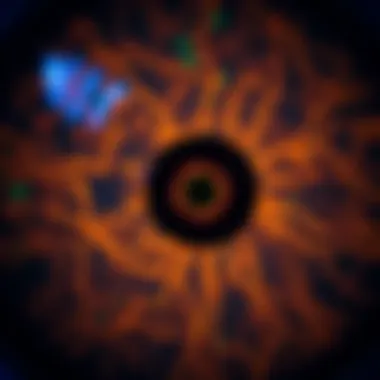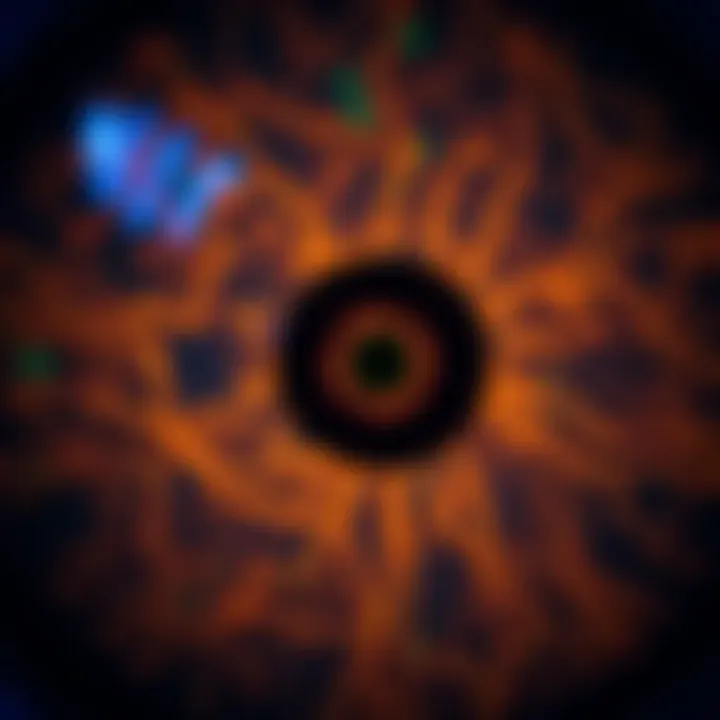Transformative OCT Systems in Modern Ophthalmology


Intro
Optical Coherence Tomography (OCT) has emerged as a remarkable tool in the field of ophthalmology, offering unparalleled imaging capabilities that have significantly changed how eye care professionals diagnose and manage various ocular diseases. With an increasing prevalence of vision-related issues driven by factors such as aging and environmental influences, an in-depth understanding of OCT systems is becoming crucial for practitioners and researchers alike. This article aims to shed light on the intricacies of OCT technologies, their clinical applications, and the ongoing advances that contribute to a deeper understanding of ocular health.
In this exploration, we will examine key concepts and terminology surrounding OCT, providing a solid foundation for grasping its significance. Furthermore, we will discuss the findings gleaned from recent studies and consider future research avenues that may arise as the technology continues to evolve. By bridging the gap between technical intricacies and clinical practice, our objective is to not only inform but also inspire a dialogue among students, educators, researchers, and professionals in ophthalmology.
As we navigate through this comprehensive guide, it will become evident that the role of OCT is not confined to mere imaging; rather, it stands as a pivotal element in revolutionizing how we approach ocular health. The capabilities it offers hold substantial promise, making it imperative to understand every nuance of OCT systems.
Prologue to Optical Coherence Tomography
In the rapidly advancing field of ophthalmology, the introduction of Optical Coherence Tomography (OCT) has ushered in a new era of diagnostic precision and quality patient care. This article aspires to unpack the intricacies of OCT systems and illuminate their transformative impact within the realm of eye health. By exploring various OCT technologies and their applications, it lays the groundwork for understanding not just the mechanics behind this imaging technique, but also its profound implications in clinical settings.
Definition and Overview
Optical Coherence Tomography is a non-invasive imaging technique that captures high-resolution cross-sectional images of the eye, allowing for detailed visualization of ocular structures. At its core, OCT utilizes light waves to take pictures of the retina, offering insight into the layers of retinal tissue that are critical for diagnosing and monitoring various ocular diseases.
When we think about its practicality, OCT serves as a cornerstone in the detection of conditions such as age-related macular degeneration and diabetic retinopathy. Apart from just imaging, the system delivers quantitative data that helps eye care professionals make informed decisions regarding treatment options. The technology enables clinicians to visualize not only the retina but also the optic nerve and anterior segment of the eye, broadening its utility in comprehensive eye assessment.
Historical Development
The journey of Optical Coherence Tomography dates back to the early 1990s. Researchers like Dr. David Huang and his team at the Oregon Health & Science University laid down the foundational principles that govern this technology. The original development was inspired by time-domain OCT methods, primarily using low-coherence interferometry to create images of internal biological structures.
Over the decades, technological innovations led to the evolution of new and improved versions of OCT. In the mid-2000s, spectral-domain OCT emerged, offering faster data acquisition and enhanced imaging resolution. This was a game-changer. Clinicians reported not just better images, but more practically, a significant enhancement in their ability to monitor disease progression and response to treatments.
Today, OCT continues to evolve. Swept-source OCT and angiography represent more recent advancements, expanding the horizons of diagnostics and offering unprecedented views of the vascular networks as well as deeper ocular structures. With such continuous improvement, the relevance of OCT in patient care grows, underlining the need for ongoing research and development in this area.
"The advent of OCT transformed how we view and treat ocular diseases, enabling unprecedented levels of diagnostic capabilities."
Fundamental Principles of OCT Technology
Optical Coherence Tomography (OCT) technology has established itself as a cornerstone in modern ophthalmic imaging. Understanding the fundamental principles behind OCT is crucial for grasping its applications and capabilities. This section aims to articulate why a solid comprehension of the foundational principles is imperative for healthcare professionals, researchers, and engineers involved in ophthalmic innovations.
The significance of these principles lies in their potential to enhance diagnostic accuracy and treatment efficacy. By integrating these fundamental concepts into clinical practice, professionals can make better-informed decisions, ultimately leading to improved patient outcomes. This understanding fosters not only a deeper appreciation of OCT systems but also advances the development of more innovative technologies in the field.
Basic Optical Principles
At the heart of Optical Coherence Tomography are foundational optical principles that govern how light interacts with biological tissues. OCT primarily utilizes light waves to produce detailed cross-sectional images of the retina and other ocular components. This imaging technique relies on a light source—commonly a superluminescent diode—which emits near-infrared light.
When this light interacts with different tissues, it experiences varying degrees of reflection and scattering, depending on the tissue's characteristics. Here’s how it breaks down:
- Light Reflection: Varies with tissue types, creating contrast in images.
- Light Scattering: Influences how much light returns to the OCT device, affecting the quality of images.
- Depth Resolution: Determined by the coherence length of the light source, which allows for fine detail imaging.
These basic optical principles underline the operational efficacy of OCT systems, being directly related to the definition and contrast of the resulting images. The ability to visualize tissues at a microscopic level is what sets OCT apart from traditional imaging methods, offering much-needed insights into ocular health.
"OCT systems represent a sophisticated marriage of optics and imaging technology, enabling clinicians to see beneath the surface of the eye in unprecedented detail."
Interference and Image Formation
The concept of interference is pivotal in discerning how OCT constructs images. OCT employs the principle of low-coherence interferometry, a method that relies significantly on how light beams can combine or cancel each other out. This is critical for image formation in OCT, breaking it down as follows:
- Interference Pattern Creation: The probe beam that is reflected off the tissue combines with a reference beam within the OCT system, resulting in an interference pattern. The characteristics of this pattern relate directly to the reflectivity and depth of the retinal structures.
- Data Acquisition: The interference signals are detected and processed to extract depth information. This is typically done using a spectrometer or photodetector that monitors the intensity of the light over different wavelengths.
- Image Reconstruction: Using complex algorithms, these acquired signals get transformed into high-resolution images. This enables clinicians to assess the architecture of retinal layers clearly, which is paramount for diagnosing various ocular conditions.
The meticulous process of interference and the sophisticated subsequent image formation is what lends OCT its distinctive power in optometry. Clinicians witnessing these images can evaluate conditions like macular degeneration or diabetic retinopathy with a level of detail that traditional methods simply can't match.
For further reading on optics principles, visit Wikipedia on Optical Coherence Tomography or explore research initiatives in this domain on ResearchGate.
Different Types of OCT Systems
Optical Coherence Tomography (OCT) has made a significant mark in the field of ophthalmology, offering an unprecedented look into ocular structures. Understanding the different types of OCT systems is crucial, as each variant brings distinct features and advantages, optimizing diagnosis and treatment strategies for various ocular diseases. By exploring these systems, one can appreciate the nuances of imaging options available today, which can influence clinical decisions and patient outcomes.


Time-Domain OCT
Time-Domain OCT (TD-OCT) is one of the earlier iterations of this imaging technology. In TD-OCT, the light source emits a beam, which is split into two paths - one directed at the sample and another at a reference mirror. By measuring the time it takes for light to return from the sample to the detector, this system can generate cross-sectional images of the retina.
Though TD-OCT laid the groundwork for what was to come, it does have its limitations. The speed at which images are captured is slower than its modern counterparts, leading to longer examination times. However, it holds a certain charm for historical significance, and some clinics still utilize these systems for their simplicity and cost-effectiveness.
Spectral-Domain OCT
Moving to more advanced technology, Spectral-Domain OCT (SD-OCT) represents a notable leap in imaging capabilities. In this system, a Michelson interferometer is used, capturing a broad spectrum of wavelengths simultaneously. This allows for a much faster acquisition of images and significantly improved resolution compared to TD-OCT.
With SD-OCT, practitioners can obtain high-resolution images of retinal layers, making it easier to diagnose and monitor conditions like diabetic retinopathy or age-related macular degeneration. This system has become the workhorse in many optical practices and hospitals thanks to its balance of speed, detail, and relatively manageable cost.
Swept-Source OCT
Swept-Source OCT (SS-OCT) takes high-resolution imaging a step further. Instead of capturing a wide spectrum of light, SS-OCT uses a tunable laser that sweeps across different wavelengths. This approach allows for deeper tissue penetration, making it particularly useful for imaging the choroid and other structures located behind the retina.
This technology’s high acquisition speed and better imaging of thicker tissues lead to improved visualization of complex conditions. As a result, SS-OCT is particularly valuable in diagnosing and managing glaucoma and other diseases where precise layering and depth information can impact treatment decisions.
OCT Angiography
OCT Angiography is a groundbreaking application of OCT technology, enabling visualization of blood flow within the retina without the need for dye injection. Utilizing motion contrast, it measures variations in intensity over time to produce detailed images of blood vessels.
This capability is revolutionary for assessing retinal vascular diseases. By allowing non-invasive mapping of the retinal and choroidal vascular systems, OCT Angiography provides ocular surgeons and clinicians with vital information without the risks associated with traditional dye-based angiograms. The precision it offers has dramatically enhanced the capacity for timely intervention in various ocular conditions.
"OCT Angiography is a game-changer in how we visualize and treat retinal diseases, providing insights that were previously hard to come by."
In summation, each type of OCT system plays a unique role in enhancing our understanding and management of ocular health. From the straightforward design of Time-Domain OCT to the intricate details unveiled by Swept-Source technology, these imaging modalities serve as indispensable tools for eye care professionals today. By familiarizing oneself with their strengths and capabilities, practitioners can leverage their features to improve patient care effectively, ultimately leading to better outcomes across the board.
Clinical Applications of OCT in Ophthalmology
Optical Coherence Tomography (OCT) has carved a niche for itself as a critical tool in modern ophthalmology. Its ability to provide cross-sectional images of the retina has revolutionary implications for diagnosing and managing various ocular conditions. This section sheds light on key clinical applications of OCT, illustrating how this technology enhances understanding, offers precise diagnostics, and facilitates effective treatments in eye health.
Macular Imaging
Macular imaging using OCT has become indispensable in assessing conditions affecting the central retina. The macula is the part of the retina responsible for sharp, detailed vision. OCT provides a high-resolution view of the macular structure, enabling practitioners to detect subtle changes that might indicate diseases like age-related macular degeneration (AMD) or diabetic macular edema.
- Detailed Visualization: OCT captures the intricate layers of the macula, allowing clinicians to visualize irregularities that could escape detection with traditional imaging methods.
- Early Detection: By identifying pathological changes at an early stage, OCT plays a crucial role in timely intervention, potentially preserving a patient's vision.
The ability to assess the thickness of retinal layers also aids in determining treatment strategies, whether it be through medications for wet AMD or laser treatments for localized edema. It’s like having a high-powered magnifying glass that reveals the essence of what's happening beneath the surface.
Optic Nerve Analysis
In terms of optic nerve health, OCT serves as a non-invasive method for evaluating the optic nerve head and the nerve fiber layer. This analysis is pivotal for detecting conditions such as glaucoma, where prompt diagnosis can significantly alter the disease trajectory.
- Thickness Measurement: OCT provides meticulous measurements of the retinal nerve fiber layer (RNFL) thickness. A thinning layer could signify glaucoma or other optic nerve pathologies.
- Progression Monitoring: Regular OCT scans enable clinicians to monitor changes over time, allowing tailored treatment adjustments based on how a patient’s condition develops.
Understanding optic nerve health is akin to keeping an eye on the company's financial reports; consistent monitoring allows for early action in case of downward trends, which is essential in maintaining long-term viability.
Retinal Disorders
Various retinal disorders, including diabetic retinopathy and retinal vein occlusion, benefit immensely from OCT. The device helps delineate the extent of damage and guides therapeutic interventions effectively.
- Layer-Specific Analysis: OCT identifies fluid accumulations and intraretinal changes, essential for diagnosing diabetic retinopathy. Clinicians can differentiate between types of edema and tailor treatment plans accordingly.
- Predictive Insights: Insights gained from OCT images can predict disease progression and responsiveness to treatments, guiding clinical decisions.
For people living with diabetic retinopathy, for instance, this technology can bring clarity when faced with fogged vision, allowing transparent navigation through the treatment path.
Glaucoma Assessment
OCT has emerged as a gold standard in the diagnosis and management of glaucoma. The technology's prowess in delivering rapid and precise assessments transforms how glaucoma is diagnosed, allowing for more efficient management strategies.
- Early-Stage Detection: With its ability to visualize fine structural changes, OCT can detect glaucoma before significant optic nerve damage occurs. Early detection is crucial since once vision loss happens, it’s typically irreversible.
- Quantitative Assessment: The device provides quantitative metrics, such as the RNFL and ganglion cell layer thickness, which can be used to establish a clear baseline and evaluate the effectiveness of treatments over time.


In summary, the clinical applications of OCT in ophthalmology are vast and impactful. Its use in macular imaging, optic nerve analysis, retinal disorders, and glaucoma assessment showcases its integral role in enhancing patient care. By facilitating early detection and ongoing monitoring, OCT is not just a diagnostic tool but a crucial partner in the journey toward maintaining and improving ocular health.
The integration of OCT in routine practice is changing the landscape of ophthalmology, providing clearer paths to diagnosis and management of complex visual disorders.
Technological Advancements in OCT Systems
In the ever-evolving field of ophthalmology, Optical Coherence Tomography (OCT) has made significant leaps forward, driving better outcomes in patient care. These advancements contribute not only to the precision of diagnostics but also enhance treatment management across various ocular diseases. The importance of following technological trends means staying ahead of the curve; in this context, it’s essential to delve deeper into three specific advancements that are shaping the future: high-resolution imaging, artificial intelligence integration, and portable devices.
High-Resolution Imaging
High-resolution imaging represents a watershed moment in OCT technology. This advancement is crucial for clinicians striving to detect subtle structural changes in ocular tissues. The capability to capture more detailed images allows for the identification of minute pathologies that might have previously slipped under the radar.
For example, advancements in scanning protocols have resulted in image resolutions reaching microns or less. This precision is invaluable when analyzing disorders such as retinal detachment or age-related macular degeneration. Think of it like switching from an old blurry television picture to a crystal-clear HD display; the level of detail unveiled can drastically alter a diagnosis.
- Benefits of High-Resolution Imaging:
- Enhanced diagnostic accuracy
- Earlier detection of diseases
- Improved monitoring of treatment outcomes
Ultimately, the more refined imaging techniques not only bolster confidence in diagnoses but can help tailor personalized treatment pathways for patients.
Artificial Intelligence Integration
The infusion of artificial intelligence into OCT systems is like adding a supercharged engine to a high-performance car. Algorithms that can analyze OCT images in real time are breaking new ground by streamlining workflows and reducing the workload on healthcare professionals. This technological development facilitates quicker interpretation of scans, allowing for faster clinical decisions.
Several studies have shown that AI can achieve diagnostic accuracy that matches or even surpasses that of seasoned specialists. For instance, AI algorithms can sift through large datasets to identify patterns and predict outcomes, leading to proactive management strategies. With machine learning capabilities improving rapidly, this integration empowers eye care practitioners to focus more on clinical care while trusting technology for efficiency.
"AI’s role in healthcare isn’t just about speed; it’s about enhancing the quality of patient care by empowering the human touch in medicine.”
Portable and Handheld Devices
There’s nothing like the convenience of having a powerful tool at your fingertips, and portable OCT devices have emerged as game-changers in the field. These compact systems bring the diagnostic prowess of traditional OCT units right to the bedside or even directly into patients' homes, which is particularly useful in underserved areas.
The application of handheld devices is invaluable during remote examinations. Clinicians can now conduct thorough eye assessments in real-time, minimizing travel needs for patients and potentially leading to increased follow-ups. Additionally, advancements in battery life and connectivity allow these devices to seamlessly integrate with existing health data systems.
- Key Features of Portable Devices:
- Mobility and ease of use
- Real-time image acquisition
- Cost-effective solutions for clinics
In summary, as the ophthalmology landscape continues to be reshaped, these technological advancements in OCT systems hold great promise. By understanding their implications, eye care specialists can harness the power of these developments to improve patient outcomes and redefine standards of care. The trajectory of OCT technology signifies a thrilling frontier, promising further innovations that we may be only scratching the surface of today.
The Role of OCT in Disease Management
In contemporary ophthalmology, Optical Coherence Tomography (OCT) assumes a pivotal role in the management of eye diseases. The technology has transcended mere imaging; it actively contributes to understanding and addressing various ocular conditions. The ability to visualize the intricate architecture of the retina and other ocular structures with remarkable clarity marks OCT as a cornerstone in disease management strategies. Its importance lies in several specific elements that directly benefit both clinicians and patients alike.
First, its precision enables early detection of diseases. This early identification is crucial, particularly for conditions like macular degeneration and glaucoma, which can result in irreversible vision loss if not diagnosed and treated promptly. With these conditions, every day can make a difference. Therefore, utilizing OCT allows clinicians to take quick action rather than waiting for symptoms to manifest or for traditional diagnostic techniques to indicate an issue.
Second, OCT systems facilitate the monitoring of disease progression. Armed with high-resolution imaging, ophthalmologists can assess changes in the retinal layers over time, providing vital clues about the disease's trajectory. By regularly capturing detailed images, clinicians gather essential data that informs necessary adjustments in treatment. This aligns closely with the evolving understanding of personalized medicine, where treatments can be tailored based on observed patient responses.
"A stitch in time saves nine.” This age-old adage rings particularly true in the context of ocular health, where timely interventions can prevent more severe complications down the line.
Additionally, OCT technology fosters improved communication between healthcare providers and patients. With the visual data provided through images, explaining conditions and treatment options becomes far less abstract. A picture truly is worth a thousand words; patients can better grasp their conditions and treatment rationale by visually witnessing the changes in their eyes. This engagement often leads to better compliance with treatment regimens, as understanding one's condition can motivate proactive participation in their health journey.
In sum, OCT's role in disease management is multifaceted. From the early detection of ocular diseases to the continuous monitoring of treatment efficacy, it equips eye care professionals with the tools necessary for making informed decisions. As research continues to evolve, so will the applicability and capabilities of OCT, ensuring that it remains at the forefront of ophthalmology.
Early Detection of Ocular Diseases
Early detection can be the cornerstone of effective intervention in ophthalmology. With the rapid advancements in OCT technology, the resolution of ocular images has vastly improved, allowing for detailed inspections of various structures, including the retina and optic nerve.
The efficacy of OCT in identifying subtle changes reflects especially well in conditions such as diabetic retinopathy, where damage can occur before symptoms are evident. Regular screening with OCT can capture these early changes, enabling timely management plans tailored to individual patients. Furthermore, repeated assessments using OCT can help track the condition, ultimately leading to better long-term outcomes.
Imagine a scenario where a patient has no noticeable symptoms of diabetic retinopathy but undergoes routine OCT scanning. The imaging might reveal early microaneurysms or retinal thickening, prompting proactive measures to avert significant vision loss down the road. Hence, it not only proves beneficial in detecting diseases but also in fostering a more proactive approach to ocular health.


Monitoring Treatment Efficacy
The capability to monitor how well a treatment is working is another significant aspect that OCT provides in the realm of disease management. Once a diagnosis is made and treatment begins, it’s paramount to have tools to gauge its effectiveness. This is where the ability of OCT to produce high-resolution images of the retina comes into play.
For instance, in managing retinal vascular diseases, clinicians can measure changes in blood flow and structural integrity over time. After starting a course of anti-VEGF injections for conditions like wet age-related macular degeneration, regular OCT scans can reveal whether there’s a reduction in fluid accumulation or structural improvement in the retina. These real-time evaluations allow quick adjustments to treatment plans if necessary, ensuring patients receive optimal care.
Moreover, OCT provides insights that help in understanding potential adverse reactions to treatments, enabling healthcare professionals to make informed decisions tailored to the patients’ needs. This dynamic approach to monitoring transforms the patient care process, moving it away from a one-size-fits-all model toward a more personalized treatment strategy.
Challenges in OCT Implementation
Implementing Optical Coherence Tomography (OCT) systems within the realm of ophthalmology presents a strikingly multifaceted set of challenges. As OCT technology continues to evolve, it holds the promise of facilitating earlier diagnoses and improving patient outcomes. However, understanding the hurdles associated with its adoption is paramount for healthcare professionals, researchers, and policymakers alike. These challenges can be broadly grouped into cost considerations and training requirements. Each element plays a pivotal role in dictating the extent to which this groundbreaking technology can be integrated into clinical practice.
Cost Considerations
Adoption of OCT technologies often comes down to financial implications. The initial setup costs for OCT systems can be rather hefty, especially for smaller clinics and hospitals that may operate with tighter budgets. Not only does the device itself come with a significant price tag, but the additional expenses like maintenance, software updates, and necessary consumables can pile on quickly.
- Purchase Price: The cost of OCT devices can vary significantly, ranging from tens of thousands to hundreds of thousands of dollars, depending on the capabilities and sophistication of the system.
- Training Expenses: Implementing an effective training program for the staff who will be operating the OCT systems adds another layer of financial burden.
- Return on Investment: The long-term value of using OCT, in terms of its potential to prevent severe ocular conditions through early detection, does need to be weighed against these start-up costs. Even if the initial outlay is steep, it can be argued that a proactive approach to patient eye health can lead to significant savings down the line.
Patients' growing expectations for state-of-the-art technology also mean that clinics must stay cutting-edge to retain their clientele. The word on the street is that patients are willing to pay more for a clinic that offers advanced diagnostics like OCT. Thus, failing to adopt this technology could result in lost business opportunities and diminished patient satisfaction.
Training and Expertise Requirements
Adopting any new technology entails a learning curve, and OCT is no exception. Many healthcare providers have found that training and expertise requirements are significant barriers to effective implementation. Understanding how to operate these sophisticated devices and interpret the resulting data is essential yet often overlooked in the planning stages.
- Operator Skill: Personnel need to develop a solid grasp on both the technical operation of the OCT equipment and the nuances of interpreting scan results. Each scan can yield intricate details that require training to interpret correctly. Without proper training, there's a real danger of misdiagnosis.
- Continuous Education: As with other medical technologies, ongoing training is necessary to keep staff updated about advancements in OCT technology and techniques. Educational resources, workshops, and professional development opportunities need to be prioritized to ensure all staff remain proficient.
- Interdisciplinary Collaboration: Employing a teamwork approach where ophthalmologists, technicians, and IT support work together can lead to more effective use of OCT systems. Collaborating allows staff to be aware of each other’s nuances and needs, thereby fostering a more knowledgeable operational environment.
In the words of a leading ophthalmologist, “Investing in training is as crucial as investing in the technology itself.”
Despite these obstacles, addressing cost considerations and training effectively can pave the way for a fruitful implementation of OCT systems, positioning healthcare facilities to leverage this cutting-edge technology in the fight against ocular diseases. By recognizing the importance of these challenges, stakeholders can work together to overcome them and maximize the potential benefits of OCT technology.
Future Directions in OCT Research
The future of Optical Coherence Tomography (OCT) in ophthalmology holds vast potential to revolutionize how we diagnose and manage various ocular diseases. This section dives into the significance of emerging technologies and research trends that promise to further enhance the capabilities of OCT systems. As the field of ophthalmology evolves, the integration of innovative imaging techniques and the expansion of clinical applications are crucial to ensuring that OCT systems remain at the forefront of eye care.
Innovative Imaging Techniques
The development of new imaging techniques will likely define the next era of OCT applications. Several promising methodologies are being explored:
- Multi-modal Imaging: Combining OCT with other imaging modalities, such as fluorescein angiography and optical imaging, can provide more comprehensive insights into retinal structures and functions. This integrated approach enhances the ability to detect diseases earlier and monitor their progression more effectively.
- Wide-field OCT: Traditional OCT systems often have a limited field of view. However, wide-field OCT technologies are making strides in capturing larger areas of the retina in a single scan. This advancement not only saves time but also improves the chances of detecting peripheral lesions that may have been missed with conventional equipment.
- Photoacoustic Imaging: This technique merges optical imaging with ultrasound. By employing sound waves generated by light absorption in tissues, photoacoustic imaging can provide both anatomical and functional information. It may allow clinicians to visualize blood flow in the eye, shedding light on conditions like diabetic retinopathy in real time.
These innovative techniques aim to boost the resolution, speed, and diagnostic power of OCT systems.
Expanding Clinical Applications
As OCT technology matures, its clinical applications are expected to broaden significantly:
- Diabetic Eye Disease Management: The continual monitoring of diabetic retinopathy using high-resolution OCT could lead to more personalized treatment strategies. This might involve adjusting therapeutic approaches based on real-time assessments.
- Neuro-Ophthalmology Applications: OCT has the potential to play a more prominent role in detecting neural disorders that affect vision, such as multiple sclerosis. Research is underway to explore OCT's capability in assessing optic nerve health and its relation to neurological conditions.
- Ocular Surgery Enhancement: OCT could facilitate better surgical outcomes by providing surgeons with detailed intraoperative imaging. Real-time feedback during procedures may help clinicians make informed decisions, minimizing complications and improving patient recovery times.
The expansion of clinical applications could ultimately provide patients with tailored treatment pathways, leading to enhanced outcomes.
"The future of OCT lies in its ability to transform how we understand and treat ocular diseases—by marrying advanced imaging with innovative clinical applications, we pave the way for a new standard of eye care."
In summary, future directions in OCT research are not merely about upgrading technology; they reflect a larger vision for improving patient care in ophthalmology. By embracing novel imaging techniques and expanding its clinical reach, OCT systems will be invaluable tools for practitioners navigating the complexities of eye health.
Closures and Implications
The exploration of Optical Coherence Tomography (OCT) systems in ophthalmology has significant practical and theoretical implications that shape the future landscape of eye care. Throughout this article, we have seen how OCT not only serves as a powerful diagnostic tool but also plays a pivotal role in enhancing patient management and treatment outcomes.
OCT's ability to provide high-resolution, cross-sectional images of the retina and anterior segment fundamentally alters how clinicians diagnose and monitor ocular diseases. The implications of the technology extend beyond mere diagnosis. It allows for timely interventions that can preserve vision and prevent irreversible damage. This proactive approach is invaluable in managing conditions like glaucoma and diabetic retinopathy, where early detection and monitoring can greatly influence long-term prognosis.
"Understanding the implications of OCT technology can lead to improved patient care and better management of ocular conditions."
The benefits of integrating OCT into routine clinical practice are numerous:
- Enhanced Diagnostic Accuracy: By providing a non-invasive way to visualize the anatomy of the eye, OCT reduces the reliance on more invasive procedures.
- Treatment Monitoring: Real-time imaging helps in assessing the effectiveness of various therapies, allowing for adjustments based on precise data rather than subjective evaluations.
- Patient Education: The visual nature of OCT scans aids in educating patients about their conditions and engaging them in treatment decisions.
Despite these advancements, the journey ahead is not without challenges. As highlighted in previous sections, the costs associated with OCT systems can be a barrier to widespread adoption, particularly in developing regions. Furthermore, ensuring that healthcare professionals are adequately trained to interpret OCT images is crucial for maximizing its potential. Ensuring all stakeholders appreciate the profound implications of OCT is vital for fostering a culture of innovation and progress in ophthalmology.







